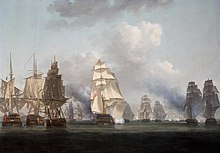Graham Moore (Royal Navy officer)
Sir Graham Moore | |
|---|---|
 Oil on canvas portrait, c. 1792, by Sir Thomas Lawrence | |
| Born | 1764 Glasgow, Scotland |
| Died | 25 November 1843 (aged 78–79) Cobham, Surrey |
| Allegiance | |
| Service | |
| Years of service | 1777–1839 |
| Rank | Admiral |
| Commands | |
| Battles / wars | |
| Awards |
|
| Relations | Dr. John Moore (father) General Sir John Moore (brother) Harriet Jane Moore (niece) |
Naval career
Moore was born in

Moore was promoted to post-captain on 2 April 1794, soon after the start of the Revolutionary War, with command of the 32-gun frigate Syren,[2] in the North Sea and the coast of France. He then commanded the 36-gun frigate Melampus from September 1795.[1] In her he took part in the Battle of Tory Island on 12 October 1798, capturing the Résolue two days later.[2] In February 1800 he went out to the West Indies, but was invalided home after eighteen months.[1]

On the renewal of the war in 1803 he was appointed to
Moore was then attached to Sir
He later served as part of the
Moore commanded
Promoted to vice-admiral on 12 August 1819,[7] he left the Board of the Admiralty in March 1820.[2] He was Commander-in-Chief, Mediterranean Fleet between 1820 and 1823[1] and was advanced to Knight Grand Cross of the Order of the Bath on 11 March 1836.[8] Promoted to full admiral on 10 January 1837,[9] he served as Commander-in-Chief, Plymouth from 1839 to 1842[1] flying his flag in Impregnable.[1]

Moore died at his home, Brook Farm, Cobham, Surrey,[10] on 25 November 1843,[1] and was buried at St. Andrew's Church.[11]
Family
In 1812 he married Dora Eden, daughter of Thomas Eden, and niece of William Eden, 1st Baron Auckland; they had one son, Captain John Moore, RN (d. 1866).[1]
Diary
Moore kept a detailed diary from 1784 until 1843, comprising thirty-four volumes, which provide a unique account of his service as a lieutenant, commander and captain.[12] The diary is held at Cambridge University Library.[13]
Namesakes
Several places were named in his honour: the
References
- ^ a b c d e f g h i j k l m n o p Laughton, John Knox (1894). . In Lee, Sidney (ed.). Dictionary of National Biography. Vol. 38. London: Smith, Elder & Co.
- ^ a b c d e f O'Byrne, William Richard (1849). A Naval Biographical Dictionary: comprising the life and services of every living officer in Her Majesty's navy, from the rank of admiral of the fleet to that of lieutenant, inclusive. London: John Murray. p. 777. Retrieved 28 October 2013.
- ^ "No. 16632". The London Gazette. 11 August 1812. p. 1585.
- ^ "No. 16972". The London Gazette. 4 January 1815. p. 19.
- ^ "Sainty, JC, Lord High Admiral and Commissioners of the Admiralty 1660–1870, Office-Holders in Modern Britain: Volume 4: Admiralty Officials 1660-1870 (1975), pp. 18–31". Archived from the original on 7 October 2014. Retrieved 4 September 2009.
- ^ Rodger, p. 69
- ^ "No. 17505". The London Gazette. 12 August 1819. p. 1446.
- ^ "No. 19365". The London Gazette. 15 March 1836. p. 495.
- ^ "No. 19456". The London Gazette. 10 January 1837. p. 69.
- ^ "Obituary : Admiral Sir Graham Moore". The Gentleman's Magazine. XXI: 317–319. 1844. Retrieved 28 October 2013.
- ^ "Moore Tomb, Church of St Andrew". British Listed Buildings. 2013. Retrieved 28 October 2013.
- doi:10.5284/1068932. Retrieved 22 July 2017.
- ^ Fulton, p. 403
- ^ "Sir Graham Moore Islands". travelingluck.com. Retrieved 10 March 2009.
- ^ "Cape Graham Moore". travelingluck.com. Retrieved 10 March 2009.
- ^ Parry, William Edward (1821). Journal of a voyage for the discovery of a North-West passage from the Atlantic to the Pacific. [1], Performed in the years 1819 - 20 in his majesty's ships Hecla and Griper. London: John Murray. p. 59.
- ^ "Status Performance Assessment: Biodiversity conservation of Western Australian Islands" (PDF). Government of Western Australia. 1 April 2010. Archived from the original (PDF) on 14 March 2018. Retrieved 4 August 2014.
Sources
- Fulton, Henry L. (2015). Dr. John Moore, 1729-1802 : a life in medicine, travel, and revolution. Newark: ISBN 978-1-61149-493-8.
- Rodger, N.A.M. (1979). The Admiralty. Offices of State. Lavenham: T. Dalton Ltd. ISBN 0900963948.
Further reading
- Wareham, Tom (September 2004). Frigate Commander. Pen and Sword. ISBN 978-1-84415-073-1.
External links
. Dictionary of National Biography. London: Smith, Elder & Co. 1885–1900.

